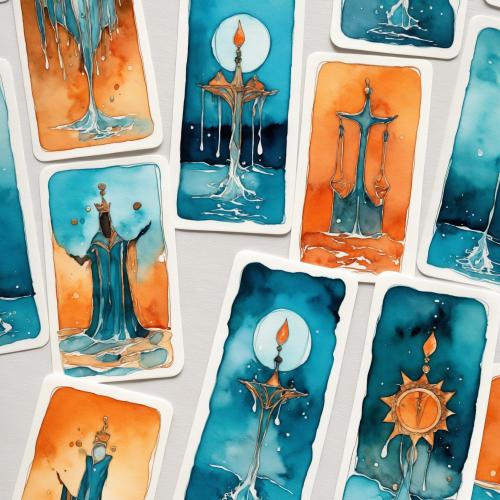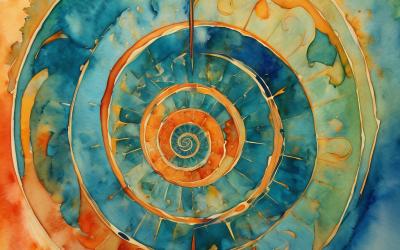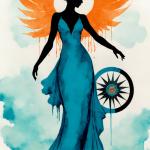Explore tarot spreads, including the three-card layout and Celtic Cross. This guide covers spread techniques, interpretation methods, and practical examples to help beginners master the art of reading tarot cards.
This article is part of my Tarot for Beginners series. If you're not already acquainted with the cards, feel free to check out my articles on The Anatomy of a Tarot Deck, The Major Arcana and The Minor Arcana before diving into this one. Today, we're going to explore how to go beyond pulling single cards so that you can get a better picture of what the cards are trying to tell us by using spreads.
The Magic of Tarot Spreads
Imagine you're standing before a vast, starry sky. Each star holds a piece of wisdom, but it can be overwhelming to make sense of them all at once. This is where tarot spreads come in - they're like constellations, helping us connect the dots and find meaning in the cosmic dance of the cards.
A tarot spread is simply a predetermined arrangement of cards. Each position in the spread represents a specific aspect of your question or situation. It's like creating a map of your inner landscape, with each card acting as a signpost along the way.
Why should we use spreads over pulling individual cards?
- They help focus our minds on specific aspects of our question, like a gentle meditation.
- They give each card a specific context, enriching its meaning.
- They reveal connections between different aspects of our lives that we might have overlooked.
- They offer a structured approach to even the most complex questions life throws our way.
The Three-Card Spread: A Perfect Starting Point
Let's start with something simple yet profound - the three-card spread. It's like dipping your toes into a cool stream on a warm day - refreshing and inviting.
Here's how it works:
- Shuffle your deck, letting your question or intention guide your movements.
- Draw three cards and lay them out from left to right.
- The first card represents the past, the whispers of what has been.
- The middle card symbolizes the present, the ground beneath your feet.
- The third card indicates the future, the seeds of what may come.
Let me share a little story. Once, I did this spread for a friend who was feeling stuck in her career. She drew:
- Past: The Hermit
- Present: The Tower
- Future: The Sun
We had a good chuckle about how accurately it reflected her situation - she had spent time soul-searching (The Hermit), was currently going through a major shake-up at work (The Tower), but the future held promise of clarity and joy (The Sun). It was like the cards were giving her a comforting pat on the back, saying, "Yes, it's tough now, but keep going!"
Yes/No Questions: When Life Calls for Simplicity
Sometimes, life asks us simple questions that seem to demand a yes or no answer. While I always encourage exploring the nuances of any situation, there are times when a straightforward approach can be refreshing.
Here are two methods I like to use:
The Single Card Method:
- Shuffle your deck, holding your question in your heart.
- Draw one card.
- Generally, upright cards whisper "yes," while reversed cards suggest "no."
The Three-Card Method:
- Draw three cards, like drawing three breaths.
- If two or more cards are upright, the universe leans towards "yes."
- If two or more are reversed, it's likely a "no."
Remember, though, that even in these simple spreads, the cards often offer more than just a yes or no. They're like wise friends who can't help but give a bit of advice along with their answer!
The Celtic Cross: The Intersection of Now and Self
Now, let me share with you my absolute favorite spread - the Celtic Cross. It's like a trusted old friend who always knows just what to ask to get to the heart of the matter. This spread is a cornerstone of my Tarot Therapy practice, and I find it endlessly fascinating for self-reflection work.
The Layout: A Map of Your Inner World

- The Present: Right in the center, like the hub of a wheel. This card isn't just about the present moment - it's the crossroads between past and future, conscious and subconscious. It's you, right now, in all your wonderful complexity.
- The Challenge: Crossing the first card, this represents the obstacle you're facing. Sometimes it's external, sometimes it's internal - often, it's a bit of both.
- The Past: Recent events or influences that have led you here. It's like looking over your shoulder at the path you've traveled.
- The Future: A glimpse of what's on the horizon. Remember, the future isn't set in stone - it's more like a weather forecast than a fixed destination.
- Above (Crown): Your conscious thoughts, hopes, and aspirations. It's what you're aware of wanting or thinking.
- Below (Foundation): Ah, the subconscious! This is the hidden undercurrent, the part of you that's operating behind the scenes. In psychological terms, you might think of this as akin to the id - your instinctual drives and deepest patterns.
- Internal Influences: This is all about your personal power in the situation. What strengths can you draw on? What actions might you take?
- External Influences: The environment around you, other people's opinions, societal pressures. It's the water you're swimming in, so to speak.
- Hopes and Fears: I like to call this the 'projection card'. It often describes what we are projecting into the future of this situation - whether it be a hope (something positive) or a fear (something negative). It's fascinating to see how our current mindset can shape our expectations.
- Outcome: The potential result if things continue on their current course. Remember, you always have the power to change the course!
- Overview (optional): After laying out the cards, I like to turn over the deck to reveal the bottom card. This becomes the 'overview' card; Like stepping back to reveal the whole picture, it can provide a theme or lens through which to view the entire reading.
Why I Love the Celtic Cross for Self-Reflection
This spread is like a Swiss Army knife for the soul. Here's why I find it so powerful:
- It's comprehensive, covering past, present, future, inner world, and outer influences.
- It goes deep into both conscious thoughts and subconscious patterns.
- It empowers you by highlighting your internal resources and potential actions.
- It acknowledges the complexity of life by looking at hopes and fears together.
- It's flexible - you can adapt the positions to focus on specific aspects of growth.
- It tells a story, helping you process and make sense of complex situations.
- It often reveals subconscious patterns that might not be immediately obvious.
Using this spread regularly is like having a heart-to-heart with yourself, facilitated by the wisdom of the cards. It's a powerful tool for personal growth and self-awareness.
A Peek into a Reading
Let me share a personal example that's close to my heart. A while back, I did a Celtic Cross reading about transitioning my tarot practice from an informal hobby into a serious career path. Here's what came up:
- Present: Eight of Pentacles
- Challenge: The Fool
- Past: Three of Wands
- Future: The Magician
- Above: The Star
- Below: Four of Cups
- Internal Influences: Knight of Wands
- External Influences: Ten of Pentacles
- Hopes and Fears: The Hermit
- Outcome: The World
- Overview: The Empress
It was fascinating how the cards mirrored my journey. The Eight of Pentacles in the present position reflected the dedication and hard work I'd been putting into honing my tarot skills. The Fool as my challenge reminded me that taking this leap required embracing uncertainty and new beginnings.
The Three of Wands in the past position showed the visioning and planning I'd done, while The Magician in the future position suggested the potential to manifest this new career, blending my various skills and interests.
Consciously, I was reaching for my dreams, as shown by The Star in the crown position. But the Four of Cups beneath the surface hinted at a fear of missing out or a subtle dissatisfaction with the status quo, pushing me towards change.
The Knight of Wands as my internal influence was spot on – I felt that passionate, entrepreneurial energy driving me forward. The Ten of Pentacles as an external influence reflected the established traditions in tarot reading and perhaps some pressure to achieve financial stability.
I chuckled at The Hermit in the hopes and fears position. It beautifully captured both my desire for the solitude and introspection that tarot work offers, and my fear of isolation in shifting to a new career.
The World as the outcome was incredibly encouraging, suggesting a sense of fulfillment and completion if I continued on this path. It felt like a nod to the holistic nature of what I was undertaking – the perfect intersection of putting myself in service of others, psychology, and introspection.
The Empress as the overview card tied it all together. It felt like a reminder to trust in abundance, to nurture this new aspect of my life, and to allow for creative growth. It also echoed the nurturing, supportive role I hoped to play for others through my tarot practice.
This reading gave me the clarity and confidence to take my tarot practice seriously, both as a career and as something I truly love doing. It highlighted the potential for personal fulfillment and service to others, aligning perfectly with my desire to blend psychology, introspection, and helping others.
Personal Reading Styles: Finding Your Own Path
One of the beautiful aspects of tarot reading is how personal it can be. There's no one "right" way to conduct a reading, despite what some might have you believe. It's all about finding a method that resonates with you and helps you connect deeply with the cards and their meanings.
For example, when it comes to revealing the cards in a spread, there are different approaches:
- Some readers prefer to turn over all the cards at once before beginning the interpretation. This gives them a complete picture to work with from the start.
- Others, myself included, like to turn over each card one at a time, interpreting it in the context of the rest of the spread as we go. This approach can create a sense of unfolding narrative.
- Some readers might shuffle and draw cards for each position separately, believing this infuses each card with the energy of its specific question or position.
Similarly, there are various schools of thought on how to shuffle, whether to use reversals, or even how to phrase questions. Some readers insist on using only traditional card meanings, while others incorporate astrology, numerology, or other decks, like oracle cards.
The key is to remember that tarot is a tool for insight and self-reflection. The "right" way to read is the way that helps you access your intuition and gain meaningful insights. As you practice, you'll develop your own style and preferences.
Don't be afraid to experiment and find what works best for you. Your unique approach is what will make your readings powerful and authentic.
A Few Final Thoughts
As you explore these spreads, remember that the most important ingredients are your intuition and your openness to insight. The cards are simply tools to help you access your own inner wisdom.
Keep a journal of your readings - it's amazing to look back and see how your relationship with the cards evolves over time. And most importantly, enjoy the process! Tarot is a journey of self-discovery, and every reading is an opportunity to know yourself a little better.
Helpful Resources
If you're hungry for more, here are some books and resources I've found particularly enlightening:
- 78 Degrees of Wisdom by Rachel Pollack - a true classic in the tarot world.
- Angelorum's Tarot Spreads for Personal & Spiritual Development - Hundreds of spreads, covering every imaginable topic!
- The Complete Book of Tarot Spreads by Evelin Burger and Johannes Fiebig - great for expanding your spread repertoire.
- Online communities like Reddit's r/tarot and the Aeclectic Tarot Forum are wonderful for connecting with fellow tarot enthusiasts.
- For practice on the go, I enjoy apps like Labyrinthos and Golden Thread Tarot.
Remember, the cards are always there when you need a little guidance or a lot of inspiration. Happy reading!






